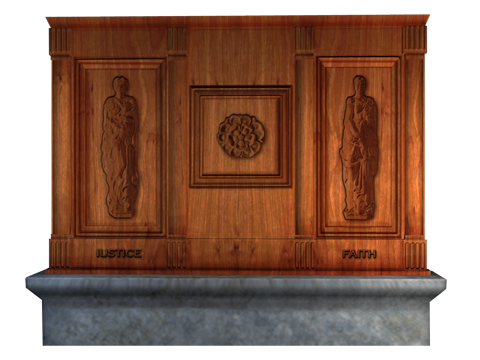Object Descriptions Great Hall
Mantelpiece
This great oak mantelpiece is fancifully modeled after two different early modern wall-pieces found in situ in Ireland today: 1) the allegorical figures in plaster wainscoting in the Long Gallery of Carrick-on-Suir, Co. Tipperary, commissioned in the 1560s by the house’s owner, Thomas Butler, tenth earl of Ormond, and 2) the undated oak mantelpiece in Sir Walter Raleigh’s house at Myrtle Grove, Youghal, Co. Cork.
In the Long Gallery at Carrick-on-Suir, the wainscoting running around the room shows the allegorized figures of Justice (holding a sword) and Equity (holding a scale) alternating with busts of Queen Elizabeth I and King Edward VI.
In the parlor at Myrtle Grove, a (West-)English-style oak mantelpiece shows the allegorical figures of Faith, Hope and Charity amid other detail-work.
The recreated mantelpiece at Kilcolman shows the paired figures of Faith (holding an anchor, an emblem of hope) and Justice (holding a sword). Both are modeled closely on the plaster figures at Carrick-on-Suir. In between them is the rose, a symbol of the English monarch. The rose connotes the Tudor family lineage as well as Queen Elizabeth herself, whose portrait is in the parlor next door.

The Great Hall was used mainly for important gatherings and ceremonial occasions. Spenser, a Protestant and lord of the manor (both owner and administrator), would conceivably have administered justice in this room, including arbitration over minor disputes between his tenants and other business on the plantation, all administered in the name of the English crown. Business conducted in front of the mantelpiece would have reminded supplicants of English law, religion and power in Munster.
Literary Connections
The rose was the Tudor family badge and an apt symbol for the queen’s beauty. In The Faerie Queene, Elizabeth is described in allegorical guise as Gloriana, the Fairy Queen, “that glorious flowre,” from whence her name: “Therefore they Glorian call that glorious flowre,/ Long mayst thou Glorian liue, in glory and great powre” (FQ II.x.76.8-9); she is “that goodly glorious flowre… sprung of the auncient stocke of Princes straine” (FQ IV.viii.33.6-7).
Elizabeth was closely associated with other flowers as well, such as the lily, a symbol of virginal purity (Elizabeth never married and carried the sobriquet “The Virgin Queen”), and the fleur-de-lis, either the lily or the iris. The fleur-de-lis in royal English heraldry connoted imperial power. It is figured on the queen’s scepter in portraits, for example, and was a stock symbol of the French monarchy. Elizabeth, like her forbearers, claimed monarchy over England, Wales, France and Ireland. It is interesting in this regard that the Irish word for “iris“ is gloiriam, also spelled gloriam in the early modern period (according the Dictionary of the Irish Language): a word close to glorian.
The sword is a symbol of Justice. Artegall, the principal hero of Book V of The Faerie Queene, the Book of Justice, is introduced along with his sword, “Chrysaor, that all other swords excelled” (FQ V.i.9.8). With it, Artegall dispenses a rough justice to villains who oppose him. Queen Elizabeth is allegorically figured in the book as Mercilla, who must not let her sword (i.e., the sword of state) grow rusty out of disuse and excessive mercy.
The 1596 edition of The Faerie Queene shows an anchor on its title page, an emblem of hope (anchora spei). The anchor was also the emblem of printer Richard Field. (The title page of the 1596 edition can be seen open on the desk in the Tower House Study.) The character of Speranza (her name meaning “hope”) offers her “siluer anchor” to the sinful hero Red Crosse Knight in Book I.x.22.2-3 of The Faerie Queene. Visitors to the Great Hall recreated here, who were loyal to Queen Elizabeth, would find symbols of faith, hope and justice to comfort them amid the turmoil surrounding Kilcolman.
Bibliography:
Jane Fenlon, “The Decorative Plasterwork at Ormond Castle—a unique survival.” Architectural History 41 (1998), 67-81.
—, Ormond Castle (Dublin: Stationary Office, 1996).
A. Bartlett Giamatti, “Elizabeth and Spenser.” The Spenser Encyclopedia. Ed. A. C. Hamilton (Toronto: U of Toronto P, 1990), 238-42.
Anna Riehl, The Face of Queenship: Early Modern Representations of Elizabeth I (NY: Palgrave Macmillan, 2010).
Mats Rydén, “flowers.” The Spenser Encyclopedia. Ed. A. C. Hamilton (Toronto: U of Toronto P, 1990), 310-11.
Links:
https://heritageireland.ie/visit/places-to-visit/ormond-castle/
(accessed 1/30/18)
[Carrick-on-Suir town council website on Ormond Castle]